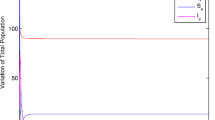Abstract
Pine wilt disease is one of the most serious conifer diseases: this is because pine trees contribute greatly to the economy and domestic wealth in Korea. Our model of this disease is based on the parametrisation of infectious pine trees in Korea for the period of 2010–2019. The model captures the growth in case onsets and the estimated results are almost compatible with the reported data. To control the spread of this disease to the whole pine tree community, we found a threshold parameter called ‘basic reproduction number’ using the next-generation matrix method. During the analysis of the model, equilibrium points were first computed: there are two points —one has no disease class and other has all the disease classes. For the global behaviour of the mathematical model of these two points, Lypunove functional theory was used for disease-free and endemic equilibrium. Sensitivity analysis was performed to observe the relative importance of these parameters to the transmission and prevalence of pine wilt disease. To control the dissemination of the disease, we formulated an optimal control problem. Strategies used to control this disease were based on the consequences of the significant effects of the estimated parameters on the basic reproduction number. We re-examined the mathematical system to determine the agreement between numerically and analytically calculated outcomes. After analysing the problem numerically, we can discern that the numerical findings support the results calculated analytically.




Similar content being viewed by others
References
Arakawa Y and Togashi K 2002 Newly discovered transmission pathway of Bursaphelenchus xylophilus from males of the beetle Monochamus alternatus to Pinus densiflora trees via oviposition wounds. J. Nematol. 34 396–404
Aslam A, Ozair M, Hussain T, Awan AU, Tasneem F and Shah NA 2021 Transmission and epidemiological trends of pine wilt disease: Findings from sensitivity to optimality. Results Phys. 26 104443
Awan AU, Hussain T, Iqbal U, Shah NH and Ozair M 2016 Qualitative behavior of pine wilt disease model. J. Basic Appl. Res. Int. 19 206–218
Awan AU, Hussain T, Okosun KO and Ozair M 2018 Qualitative analysis and sensitivity based optimal control of pine wilt disease. Adv. Differ. Equ. 2018 1–19
Awan AU, Ozair M, Din Q and Hussain T 2016 Stability analysis of pine wilt disease model by periodic use of insecticides. J. Biol. Dynam. 10 506–524
Bernoussi A 2019 Global stability analysis of an SEIR epidemic model with relapse and general incidence rates. Appl. Sci. 21 54–68
Chitnis N, Hyman JM and Cushing JM 2008 Determining important parameters in the spread of malaria through the sensitivity analysis of a mathematical model. B. Math. Biol. 70 1272
Diamandescu A 2019 \(\psi \)-asymptotic stability of solutions of a nonlinear Lyapunov matrix differential equation. Appl. Sci. 21 96–106
Fleming WH and Rishel RW 2012 Deterministic and stochastic optimal control. Springer Science & Business Media
Hussain T, Aslam A, Ozair M, Tasneem F and Gomez-Aguilar, JF 2021 Dynamical aspects of pine wilt disease and control measures. Chaos Soliton. Fract. 145 110764
Kim BN, Kim JH, Ahn JY, Kim S, Cho BK, Kim YH and Min J 2020 A short review of the pinewood nematode, Bursaphelenchus xylophilus. J. Toxicol. Environ. Health Sci. 12 297–304
Kiyohara T and Tokushige Y 1971 Inoculation experiments of a nematode, Bursaphelenchus sp., onto pine trees. J. Jpn. Forest. Soc. 53 210–218
Kobayashi F, Yamane A and Ikeda T 1984 The Japanese pine sawyer beetle as the vector of pine wilt disease. Annu. Rev. Entomol. 29 115–135
LaSalle JP 1976 The Stability of Dynamical Systems, Regional Conference Series in Applied Mathematics, Society for Industrial and Applied Mathematics, Pennsylvania. Am. Nat. 110 79–99
Lee KS and Kim D 2013 Global dynamics of a pine wilt disease transmission model with nonlinear incidence rates. Appl. Math. Model. 37 4561–4569
Lenhart S and Workman JT 2007 Optimal control applied to biological models (Chapman and Hall, CRC London, Boca Raton
Lukes DL 1982 Differential equations: classical to controlled. (Academic Press, New York)
Mamiya Y 1988 History of pine wilt disease in Japan. J. Nematol. 20 219–226
Mamiya Y and Enda N 1972 Transmission of Bursaphelenchus lignicolus (nematoda: Aphelenchoididae) by Monochamus alternatus (coleoptera: Cerambycidae). Nematologica 18 159–162
Morimoto K and Iwasaki A 1972 Role of Monochamus alternatus (Coleoptera: Cerambycidae) as a vector of Bursaphelenchus lignicolus (Nematoda: Aphelenchoididae). J. Jpn. Forest. Soc. 54 177–183
Ozair M 2014 Analysis of pine wilt disease model with nonlinear incidence and horizontal transmission. J. Appl. Math.https://doi.org/10.1155/2014/204241
Ozair M, Hussain T, Awan AU, Aslam A, Khan RA, Ali F and Tasneem F 2020 Bio-inspired analytical heuristics to study pine wilt disease model. Sci. Rep. 10 3534
Ozair M, Hussain T, Shi X, Tasneem F and Gomez-Aguilar JF 2020 Dynamical features of pine wilt disease model with asymptotic carrier. Eur. Phys. J. Plus 135 1–28
Ozair M, Shi X and Hussain T 2016 Control measures of pine wilt disease. Comput. Appl. Math. 35 519–531
Pontryagin LS 1987 Mathematical theory of optimal processes. CRC press
Romero J, Awan AU, Hussain T, Ozair M, Aslam A, Ali F and Sharif A 2020 Analysis of a mathematical model for the pine wilt disease using a graph theoretic approach. Appl. Sci. 22 189–204
Takasu F 2009 Individual-based modeling of the spread of pine wilt disease: vector beetle dispersal and the Allee effect. Popul. Ecol. 51 399–409
Takasu F, Yamamoto N, Kawasaki K, Togashi K, Kishi Y and Shigesada N 2000 Modeling the expansion of an introduced tree disease. Biol. Invasions 2 141–150
Togashi K and Arakawa Y 2003 Horizontal transmission of Bursaphelenchus xylophilus between sexes of Monochamus alternatus. J. Nematol. 35 7–16
Shi X and Song G 2013 Analysis of the mathematical model for the spread of pine wilt disease. J. Appl. Math.https://doi.org/10.1155/2013/184054
Van den Driessche P and Watmough J 2002 Reproduction numbers and sub-threshold endemic equilibria for compartmental models of disease transmission. Math. Biosci. 180 29-48
Wingfield MJ and Blanchette RA 1983 The pine-wood nematode, Bursaphelenchus xylophilus, in Minnesota and Wisconsin: insect associates and transmission studies. Can. J. Forest Res. 13 1068-1076
Wingfield MJ, Blanchette RA and Nicholls TH 1984 Is the pine wood nematode an important pathogen in the United States? J. Forest. 82 232–235
Yoshimura A, Kawasaki K, Takasu F, Togashi K, Futai K and Shigesada N 1999 Modeling the spread of pine wilt disease caused by nematodes with pine sawyers as vector. Ecology 80 1691–1702
Zhao BG, Futai K, Sutherland JR and Takeuchi Y 2008 Pine wilt disease (Springer)
Author information
Authors and Affiliations
Corresponding author
Additional information
Communicated by Sreenivas Chavali
Corresponding editor: Sreenivas Chavali
Rights and permissions
About this article
Cite this article
Ozair, M., Hussain, T., Abro, K.A. et al. Role of pine wilt disease based on optimal control strategy at multiple scales: A case study of Korea. J Biosci 46, 93 (2021). https://doi.org/10.1007/s12038-021-00208-9
Received:
Accepted:
Published:
DOI: https://doi.org/10.1007/s12038-021-00208-9




